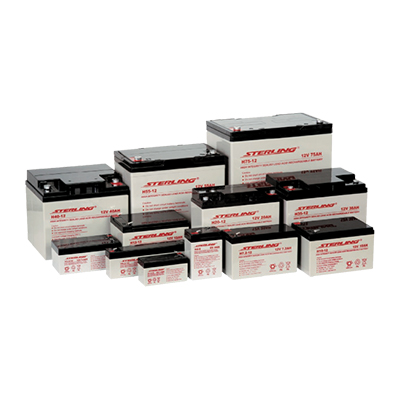M11 Business Link
Stansted
Essex, CM24 8GF
United Kingdom
SterlingHPC225-6
Sterling SLA Battery
This Sterling HPC225-6 6v 225Ah Deep Cycle AGM Plus Carbon Battery is a great solution for many applications such as Traffic Management Systems, Golf or Electric Vehicles, Aerial Equipment, Cleaning Machines and Renewable Energy Installations..
Sealed Construction
Sterling's unique construction and sealing technique ensures no electrolyte leakage from case or terminals.
Electrolyte Suspension System
This HPC series battery utilise Sterling's unique electrolyte suspension system incorporating a microfibre glass mat to retain the maximum amount of electrolyte in the cells. The electrolyte is retained in the separator material and there is no free electrolyte to escape from the cells.
Control of Gas Generation
The design of this HPC series battery incorporates the very latest oxygen recombination technology to effectively control the generation of gas during normal use.
Valve Regulated Design
The batteries are equipped with a simple, safe low pressure venting system which releases gas and automatically reseals should there be a build up of gas within the battery due to severe overcharge. Note. On no account should the battery be charged in a sealed container.
Can't find what you're looking for? Not sure which product you require or need extra help selecting the right one?
Call 03300 412 187 and speak to one of our friendly advisors today.
Lines Open: 9:30am - 5:00pm Mon/Fri.
| Voltage | 6v |
|---|---|
| Capacity at 20-hour Rate | 225Ah |
| Length | 260mm |
|---|---|
| Width | 180mm |
| Height | 247mm |
| Total Height | 253mm |
| Mean Weight with Acid | 30.5kg |
|---|
| Battery Layout | 1 |
|---|
| Delivery on Pallet | Yes |
|---|


Sterling's high integrity valve regulated lead acid (VRLA) batteries operate as a starved electrolyte system, in which the electrolyte is limited to the amount that either is absorbed in the batteries plates or wets the fibres in the separator.
The resulting system allows gases produced during overcharge to diffuse from one plate to the other and to be recombined back into the electrolyte. This recombination creates a closed system, thus reducing the release of gases into the atmosphere under normal discharge conditions.
Since the electrolyte is recycled, there is no need to add water to the batteries. This reduced maintenance leads to longer-life battery in a clean and compact container that can be installed when flooded batteries are impractical.